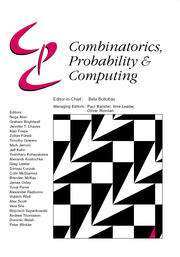Article contents
On the mixing time of coordinate Hit-and-Run
Published online by Cambridge University Press: 25 August 2021
Abstract
We obtain a polynomial upper bound on the mixing time  $T_{CHR}(\epsilon)$ of the coordinate Hit-and-Run (CHR) random walk on an
$T_{CHR}(\epsilon)$ of the coordinate Hit-and-Run (CHR) random walk on an  $n-$dimensional convex body, where
$n-$dimensional convex body, where  $T_{CHR}(\epsilon)$ is the number of steps needed to reach within
$T_{CHR}(\epsilon)$ is the number of steps needed to reach within  $\epsilon$ of the uniform distribution with respect to the total variation distance, starting from a warm start (i.e., a distribution which has a density with respect to the uniform distribution on the convex body that is bounded above by a constant). Our upper bound is polynomial in n, R and
$\epsilon$ of the uniform distribution with respect to the total variation distance, starting from a warm start (i.e., a distribution which has a density with respect to the uniform distribution on the convex body that is bounded above by a constant). Our upper bound is polynomial in n, R and  $\frac{1}{\epsilon}$, where we assume that the convex body contains the unit
$\frac{1}{\epsilon}$, where we assume that the convex body contains the unit  $\Vert\cdot\Vert_\infty$-unit ball
$\Vert\cdot\Vert_\infty$-unit ball  $B_\infty$ and is contained in its R-dilation
$B_\infty$ and is contained in its R-dilation  $R\cdot B_\infty$. Whether CHR has a polynomial mixing time has been an open question.
$R\cdot B_\infty$. Whether CHR has a polynomial mixing time has been an open question.
Keywords
MSC classification
Information
- Type
- Paper
- Information
- Copyright
- © The Author(s), 2021. Published by Cambridge University Press
References
- 8
- Cited by


